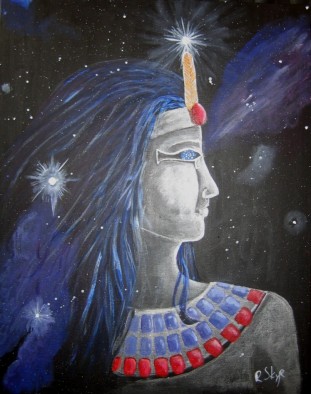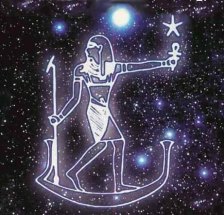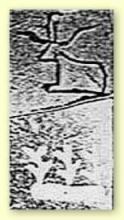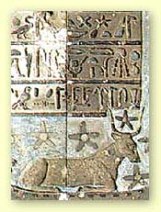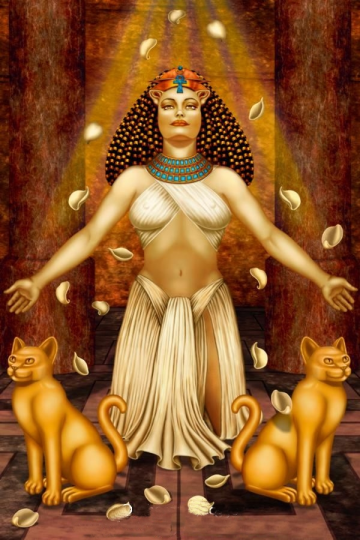
“Bast – Egyptian Cat Goddess” by Sharon George
“Bast’s themes are animals, magic, overcoming, playfulness, joy and humor. Her symbols are cats. Bast is the Egyptian cat-faced Goddess of sorcery, beneficence, joy, dance and fertility. Being a cat in nature, Bast teaches us to land on our feet in any situation, using a positive, playful attitude as our best ally. Bast and Her minions were so revered in Egypt that to kill cats was a crime punishable by death. Archaeologists uncovered mummified cats there, whose owners wanted the companionship of cats even in the afterlife. May is one of Bast’s traditional festival months.
In Belgium, people dress as cats today and hold a parade, known as The Kattenstoet, in which Bast is featured as the Queen of Cats. So think cat magic! If there’s a cat in your life, pamper the creature today and include it in spell craft as a magical partner (traditional ‘catty’ role in history). For example, if you find any of your cat’s whiskers, keep them. These may be burned for Bast in return for a wish. Or, carry a pinch of cat hair to tickle your funny bone.
Painting the image of a cat on a paper lantern and lighting it (with either a bulb or flame) draws Bast’s attention and energies to you. Or, carry a cat’s eye in your pocket today to begin developing catlike instincts and playfulness.”
(Patricia Telesco, “365 Goddess: a daily guide to the magic and inspiration of the goddess”.)
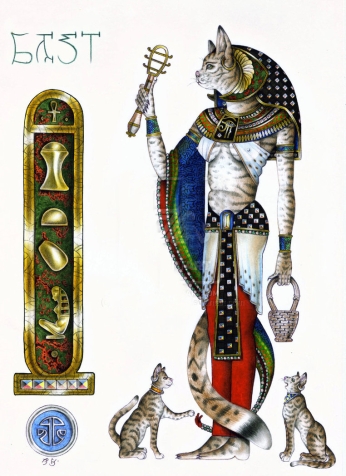
“Bast” by *Badhead-Gadroon
“Bast, Egyptian Goddess of sensual pleasure, protector of the household, bringer of health, and the guardian saint of firefighters – was the original mistress of multi-tasking! Bast is a daughter of the Sun God, Ra, sister of Sekhmet (wife of Ptah) and wife of Anubis. One of the most ancient of the Egyptian Goddesses, She is depicted as a slender woman having the head of a domestic cat. Sometimes She is shown holding a sistrum, a rattle used as a musical instrument in ancient times. Agile and lithe, Bast was recognized as the Goddess of music and dance. Her worship began around 3500 BCE, before the invention of writing.” [1]
According to Patricia Monaghan, “Bast originated in the Nile delta, but by 930 BCE, the power of Bast was acknowledged by all Egyptians, even those a thousand miles south of Her original home. At first She was lion Goddess of sunset, symbolizing the fertilizing force of the sun’s rays. Later Her image grew tamer: She became a cat carrying the sun, or a cat-headed woman who bore on Her breastplate the lion of Her former self.

“contest prize – bast” by myworld1
Bast ruled pleasure and dancing, music and joy. At the city of Bubastis (“house of Bast”), the center of Her worship, great celebrations were held. Boatloads of worshippers – hundreds of thousands of them, Herodotus said – were greeted by pleasant flute melodies as they debarked for a worship service combined with a vast trade fair. Bast’s followers believed that in return for this reverent celebration Bast bestowed both mental and physical health.

As part of Bast’s worship, Egyptians honored live cats. Domesticated (if cats can ever truly be said to be domesticated) during the early period of agriculture, cats were useful to keep down the rodent population and therefor to assure a stable diet for humans. Egyptians cherished their cats, often decking them with golden earrings or other jewelry. When they died, the cats were mummified and buried in the vast cat cemetery at Bubastis.” (p. 66 – 67).
“Cats were honored in the temples of Bast and many felines were in permanent residence there. If a local house caught on fire, the cats would be dispatched to run into the flames, drawing them out of the building. (History’s first record of a fire brigade!)” [2]

“Bast” by MaatKaaRe
[As mentioned earlier] “Bast began Her life as a protector Goddess of Lower Egypt. She was as a fierce lioness; Her name is given to mean ‘devourer‘. She is usually shown in art as a cat-headed woman carrying a basket or as a whole cat. Quite often though, there are kittens at Her feet in the pictures. A woman who wanted children sometimes wore an amulet showing the Goddess with kittens, the number of which indicated her own desired number of children.

“Bast” by valse-des-ombres
Bast is the protector of cats, women and children. There are many legends that connected Her as an ancient sun and War Goddess. One legend says that She accompanied the sun god, Ra’s, boat for a million years on its daily journey through the sky. At night She was said to transform Herself into a cat to protect Her father from Apep, a serpent – Her father’s greatest enemy. His greatest and strongest followers attempted to kill the vile creature, but to no avail. Eventually, Bast, with Her superb feline night vision, managed to destroy the serpent thereby ensuring humankind that the warmth of the sun would continue to bless the earth. Ever watchful, Bast protected Her father from his enemies, thereby becoming known as the ‘Lady of the East’, ‘Goddess of the Rising Sun’, and ‘The Sacred and All-Seeing Eye’. As a protector, She was seen as a defender of the Pharaoh.

“funeral dance” by B-a-s-t-e-t
Bast can be viewed as an integrative Goddess in Her several aspects. She is both the sun and the moon. In fact, She is one of the few sun Goddesses that can also be classified as a moon Goddess; Her glowing cat eyes reminds us of the moon that they reflect. She is venerated for singing, dancing, and childbirth suggesting ritualistic ceremonies. Above all, She is concerned with the enjoyment of life and the joy of music, dance, and bright colors. Her shrine in Baubasis was fashioned with blocks of pink granite with an entrance lined with trees. It was once one of the most beautifu temples in the world, but, alas, today, no shrines or temples remain of Bast in Egypt; even Bubastis is mostly in ruins.

“Egyptian Goddess Bast” by Diveena
Her name translates as ‘female of the ointment jar‘; hence She would gradually become the Goddess of Perfumes and Oils. In connection with this, when Anubis became the god of embalming, Bast, as Goddess of ointment, came to be regarded as his wife.

Statues of cats are commonly passed off as facsimiles of Bast, but this is incorrect. The cat was indeed Her sacred animal and the people of the time tended to see the Goddess in every cat that walked past, but Her original depiction was as a royal lady or a priestess with a cat’s head. The ancient Egyptians celebrated Her feast day on October 31st with lots of merry making, music, dancing in the streets and drinking with friends. Sadly, in modern times, Bast and Her feast day are overlooked, but you could perhaps say that Halloween was originally celebrated as the Feast of Bast.
She also has the gift, like all cats, of looking deep into your soul.Take a moment today to honor this ancient Egyptian Goddess. Light a green candle, Her sacred color, and be affectionate to a cat, Her cherished animal. When you address a cat, remember you are speaking to a little divinity, and a creature beloved of Bast.” [3]
“The Egyptian Goddess Bast reminds us of all that is feline and feminine. Her gifts, very cat-like in nature, include the refusal to be at everyone’s beck and call and an insistence on the freedom of expression. She teaches us to relax and never waste energy, reminding us to luxuriate in beauty, perfume, and to sway in graceful movement. Bast refuses to take anything too seriously. But most importantly, Bast leads us to accept the true nature of things (ourselves included) and helps us remain unswayed by the opinion of others. Curled up like a cat lying in the sun, the Goddess Bast foms a complete circle . . . a symbol of the eternal.” [4]

“Bast” by Lisa Hunt
ASSOCIATIONS:
General: Cats, rising sun, utchat (the “All-Seeing Eye”), pottery jars as perfume holders, parades (and floats), castanets and rattles (as musical instruments), beer, music and dance.
Animals: Domestic cats, lions
Plants: Cattails and other reeds, yew, cypress, mint (especially catmint), barley, and hemp
Perfumes/Scents: Musk, cinnamon, frankincense, myrrh, hemp, catnip, vervain, sandalwood, geranium, and lavender
Gems and Metals: Cat’s eye, sunstone, agate [esp. fire agate], jasper, lapis lazuli, pyrite, and jasper
Colors: Black, gold, red, turquoise, clay and silver [5]
Also seen as Bastet, Baast, Pacht, Pasht Pasch, Ubast, Ubasti and Baset.
Sources:
Goddessgift.com, “Bast, Goddess of Protection and Pleasure“.
Goddessgift.com, “Goddess Symbols: Bast“.
Monaghan, Patricia. The New Book of Goddesses and Heroines, “Bast”.
MXTODIS123. An Inner Journey: The Moon, Mythology, and You, “Bast“.
Suggested Links:
Carnaval.com, “Bast“.
Egyptian Myths, “Bastet“.
Fearn, Tranquillity. Order of the White Moon, “Bast: Queen of Cats“.
Goddess-guide.com, “The Egyptian Cat Goddess Bast“.
HDW Enterprises & Foothill Felines Bengals, “The History of the Domestic Cat“.
Hill, J. Ancient Egypt Online, “Ancient Egyptian Gods: Bast“.
Moggies, Home of the online Cat Guide, “Bastet – Cat Goddess“.
MXTODIS123. An Inner Journey: The Moon, Mythology, and You, “Bast“
Revel, Anita. igoddess.com, “Bast: enjoy play-time – Egyptian cat goddess“.
Seawright, Caroline. Tour Egypt, “Bast, Perfumed Protector, Cat Goddess…“
Temple of Creation, “Working with the Goddess Bast“.
Tiamat, Avalon Sakti. Way of the Wild Rose, “The Goddess Bast“.
Wikipedia, “Bastet“.








